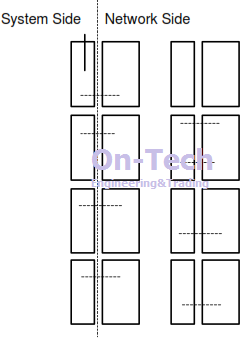Definition of MDF
Last updated: 17 Jun 2025 | 9839 Views |

A Main Distribution Frame ( MDF ) serves as a flexible connection/ testing point between the telephone exchange equipment and the subscriber cabling and can be grouped into types designed for use in Analogue or Digital Exchanges or a Hybrid variant for use in either type of exchange.
All share a common structure, being divided into two distinct units, the System Side, connecting the Exchange equipment, and the Network Side, connecting the subscribers, interconnection between the two sides is achieved using jumpering or patch cords.
| Terminal blocks for the System side are normally of the "connection" type with monitoring and/or test facilities, allowing the cabling to be tested from the MDF back to the equipment. On the Network side the terminal blocks should have the facility to provide over-voltage and/or over-current protection, as well as disconnection and both way ( to exchange or to subscriber ) test capabilities. Over-voltage and/or over-current protection isolates the vulnerable Exchange circuitry from any electrical disturbances ( lightning, mains power etc. ) on the Subscriber lines. |
Analogue and early Digital Telephone exchanges had fixed port numbers i.e. the directory number associated with the port was fixed, which could lead to excessively long jumper runs.
Modern Stored Program Control exchanges have ports with flexible numbering, which allows shorter fixed jumper runs and consequently less re-jumpering on moves and changes.
Cross connection /jumpering between the Exchange and Network side is normally done with twisted pair cable of a similar size to the cabling ( 0.4...0.65 mm ), this is the flexible point in the connection, allowing any subscriber to be connected to any System port.
Many different System / Network side arrangements have evolved over the years for MDF's, some of the most common are shown below.
|
|
|
|
|
Related content
LSA-PLUS contact technology
21 Dec 2015
Manhole
1 Mar 2019








